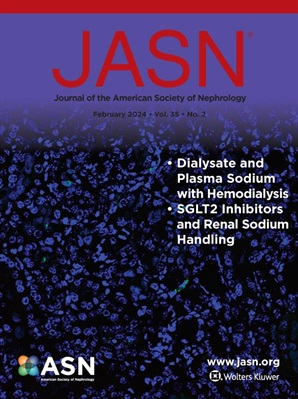索他利氟嗪对 1 型糖尿病合并慢性肾脏病患者的疗效和安全性。
IF 10.3
1区 医学
Q1 UROLOGY & NEPHROLOGY
Journal of The American Society of Nephrology
Pub Date : 2025-05-01
Epub Date: 2024-11-01
DOI:10.1681/ASN.0000000540
引用次数: 0
摘要
背景:本分析评估了索他利氟嗪(一种SGLT1&2双重抑制剂)与胰岛素并用治疗1型糖尿病和慢性肾脏病(CKD)患者的疗效和安全性:我们利用为期 52 周的 inTandem1&2 合并试验和为期 24 周的 inTandem3 试验的数据,评估索他利氟嗪(每天 200 毫克 [仅 inTandem 1&2] 或 400 毫克] 与安慰剂相比对糖化血红蛋白(HbA1c;主要终点)、体重、收缩压 (BP)、胰岛素剂量以及安全性终点(包括判定的严重低血糖和糖尿病酮症酸中毒 (DKA))的影响,并按 CKD 进行分层。结果在 237/1575 名 inTandem1&2 参与者和 228/1402 名 inTandem3 参与者中发现了 CKD。在第 24 周,经安慰剂调整后,HbA1c 明显降低--inTandem1&2:非 CKD 亚组(sotagliflozin 200mg:-0.4%, 95% CI -0.4 to -0.3; 400mg:-0.4%,95% CI -0.5至-0.3)和CKD亚组(索他克列嗪200毫克:-0.4%,95% CI -0.5至-0.3):-0.4%,95% CI -0.6至-0.1;400mg:400毫克:-0.3%,95% CI -0.5至-0.1)。在inTandem1&2中,非CKD亚组的收缩压在第24周时显著降低,但对CKD亚组没有影响。第52周时,在inTandem1&2的CKD亚组中,索他利氟嗪的严重低血糖发生率(200毫克为7%,400毫克为4%)低于安慰剂(17%),而在非CKD亚组中,严重低血糖发生率为5-6%。安慰剂、200 毫克和 400 毫克在第 52 周时,CKD 亚组的 DKA 诊断发生率分别为 1%、5% 和 3%,而非 CKD 亚组的 DKA 诊断发生率分别为 0%、3% 和 4%。除了在CKD和非CKD亚组中索他利氟嗪与安慰剂相比收缩压显著降低外,inTandem3的结果基本相似:在1型糖尿病合并慢性肾脏病的患者中,索他利氟嗪治疗的HbA1c、体重和收缩压降低效果与不合并慢性肾脏病的1型糖尿病患者相似。此外,索他利氟嗪发生严重低血糖的风险较低,甚至为中性,而且在少数DKA事件中,索他利氟嗪不会显著增加DKA风险。本文章由计算机程序翻译,如有差异,请以英文原文为准。
Efficacy and Safety of Sotagliflozin in Patients with Type 1 Diabetes and CKD.
求助全文
通过发布文献求助,成功后即可免费获取论文全文。
去求助
来源期刊
CiteScore
22.40
自引率
2.90%
发文量
492
审稿时长
3-8 weeks
期刊介绍:
The Journal of the American Society of Nephrology (JASN) stands as the preeminent kidney journal globally, offering an exceptional synthesis of cutting-edge basic research, clinical epidemiology, meta-analysis, and relevant editorial content. Representing a comprehensive resource, JASN encompasses clinical research, editorials distilling key findings, perspectives, and timely reviews.
Editorials are skillfully crafted to elucidate the essential insights of the parent article, while JASN actively encourages the submission of Letters to the Editor discussing recently published articles. The reviews featured in JASN are consistently erudite and comprehensive, providing thorough coverage of respective fields. Since its inception in July 1990, JASN has been a monthly publication.
JASN publishes original research reports and editorial content across a spectrum of basic and clinical science relevant to the broad discipline of nephrology. Topics covered include renal cell biology, developmental biology of the kidney, genetics of kidney disease, cell and transport physiology, hemodynamics and vascular regulation, mechanisms of blood pressure regulation, renal immunology, kidney pathology, pathophysiology of kidney diseases, nephrolithiasis, clinical nephrology (including dialysis and transplantation), and hypertension. Furthermore, articles addressing healthcare policy and care delivery issues relevant to nephrology are warmly welcomed.

 求助内容:
求助内容: 应助结果提醒方式:
应助结果提醒方式:


